Plants, Environment, Agriculture
1/128
There's no tags or description
Looks like no tags are added yet.
Name | Mastery | Learn | Test | Matching | Spaced |
|---|
No study sessions yet.
129 Terms
How do we feed our future generations?
1. Global population has tripled (1950-2020) yet we have harvested from the same amount of land
Crop production and yield has increased by
cultivating land covered in rainforests
enhancing food production from arable land
lowering food waste habits by humans
prioritizing staple crops > luxury crops
How can we increase yields and reduce environmental impact?
CURRENTLY:
1. monoculture = soil degradation, nutrient depletion, low biodiversity
bred/GMO crops = resistant weeds/crops
increase fertilizer = increased N2 into waters/algal bloom/eutrophication
pesticides = pest resistance, harms to human health
increased water usage
(Current Invasive Species) How can we control invasive species?
Stiga hermonthica = parasitic. attaches to plant roots and depletes nutrients
colorado beetle = attacks potato crops
wheat stem rust = hard to control. Some strains very resistant
Differences between traditional breeding and genetic modification
Traditional: crossing plants to produce offspring with desired traits
VS
Mutagenesis: changes in genome due to chemical exposure/radiation. Unpredictable and hard to assess
RNA interference: silencing targeted RNA
Transgenics: genetic material from one organism introduced into another. Recombinant DNA
How can plants contribute to energy crisis?
currently, 30% of maize is used for ethanol, when it could be used for food
miscanthus giganteus (C4!!) is a bioenergy crop grown on land unsuitable for food production, thus also preventing erosion
What new scientific approaches will be vital in the future?
antioxidant enriched tomatoes (reduces cancer/disease risk)
vitamin A enriched rice (immune health/vision)
converting non legumes to legumes (fixes N2)
Green Revolution
Modern agriculture techniques increase overall crop yield
C3 vs C4 cs CAM
C3 plants undergo photorespiration which is a wasteful process because O2 accumulates, and carbon is less efficiently converted to G3P in the Calvin Cycle. Thus, there is less photosynthetic activity. A majority of plants are C3, such as rice.
C4 plants shields O2 build up with closed stomata. Their "turbocharger" processes CO2 to G3P without O2 interference. C4 plants are much more efficient in hot/dry conditions, as CO2 is concentrated and photorespiration is minimized.
CAM plants take in CO2 when their stomata open only at night, when temps are lower and humidity is higher. This reduces the amount of water lost during transpiration, making CAM plants thrive the best in arid climates such as deserts.
Alexander von Humboldt
"Father of Ecology"
findings:
Around the globe, plant morphology is different as you are in different parts of the world
isotherms: lines on a map connecting points that have the same temperature
isobars: lines on a map connecting points that have the same atmospheric pressure
Augustin de Candolle
findings:
life forms and adapts because of temperature, moisture, and modular growth
megatherm: organism that thrives in high heat biomes (ie rainforest)
mesotherm: organism that thrives in middle heat biomes (ie grasslands)
microtherm: organism that thrives in low heat biomes (ie forest)
hekistotherm: organism that thrives in lowest heat biomes (ie tundra)
xerophile: organism that thrives in the driest biomes (ie desert)
Vladimir Koppen
findings:
classified biomes
Atmospheric Circulation
In Hadley and Polar cells, lower air is pulled toward equator, and higher air moves toward poles. In Ferrel cells, lower air moves toward poles, and higher air is pulled toward equator. These cell movements induce the wetness and dryness of alternating biomes.
closer to equator results in a faster speed of axis rotation, thus creating wind deflection
4 contrasting global biomes
desert
grasslands/savanna
tropical rainforest
tundra
Biomes
alternate wet + dry
altitude and latitude shift biome conditions
affected by abiotic factors - precipitation, temperature, soil, geology
Contrasting global biome - 1. Hot Desert
very dry, hot days/cold nights, thin/porous soils
plant adaptations:
C4 and CAM plants
no leaves (cacti) means less surface area, thus less transpiration (water loss)
morphology that can trap morning fog to hold onto moisturee
light reflecting surfaces on plants instead of heat absorbing surfaces
Contrasting global biome - 2. Tundra
cold - classified by permafrost, "permanently" frozen soil layer
short growing season with moderate temperatures
low-lying lands without trees
plant adaptations:
low meristems insulated by snow to keep themselves warm
shifting to low optimal temperature
dormancy by slowing growth to bear conditions
Contrasting global biome - 3. Tropical Rainforest
canopies with different microclimates, thus different microecosystems
highest biodiversity
poor soil because nutrients/biomass all sitting above ground/in the canopies. Because of this, deforestation is especially destructive
plant adaptations
drip tips: large waxy leaves to rid fungus/mold otherwise growing from humidity
prop roots: allowing transport in otherwise shallow soils
epiphytes: plants growing on trees without interfering with the weak soil. They have no root system and absorb nutrients from the air
adapting to low lighting due to canopies
Contrasting global biome - 4. Savanna
grassland with scattered grasses and trees. Lots of herbivores
plant adaptations:
prickles/spines/thorns to deter herbivory
indigestible/unpalatable structures (ex silica in grass)
convergent evolution combatting similar issues
Anthropogenic biomes (Anthromes)
terrestrial land following contemporary, human-altered transformations
ex croplands, urban areas
Prehistoric/carboniferous forests
Had higher levels of CO2, lower levels of O2. Period of proliferation of all forms of life
Prokaryotic vs Eukaryotic Cells
Prokaryotic (Bacteria & archaea):
nucleoid to store DNA
plasmid for antibiotic resistance
cell wall
flagella for movement
Eukaryotic (eukarya):
nucleus to store DNA
peroxisomes to rid radicals/cancer cells
mitochondrion to generate ATP
(in plants) chloroplast & cell wall
Vascular system
"plumbing" system in plants to transport water and minerals
xylem: distributes water/minerals upwards, cool plants. Roots --> stem/leaves
phloem: carries energy from photosynthesis down to roots. Leaves --> stem/roots
Evolution of photosynthesis
Photosynthesis evolved in bacteria. Eukaryotes began to photosynthesize via endosymbiosis of photosynthetic bacteria
Endosymbiosis
primary: cell takes in photosynthetic cyanobacteria. that cell now contains a chloroplast, and the chloroplast has a double membrane
secondary: a new cell takes in a primary endosymbiote. this secondary cell now contains a chloroplast
Evolution of land plants
First plants: Glaucophytes - unicellular, first photosynthetic organisms
Red Algae - multicellular, photosynthetic pigment, seaweed
Green Algae - freshwater algae that comprise phytoplankton. Green algae evolved so that zygotes wouldn't dry out on land
Charophytes - pond organisms with no vascular system
Land plants - land organisms with vascular system
Bryophytes
Nonvascular, simple land plants. Roots utilized for anchorage rather than water intake.
Liverworts, hornworts, moss.
Liverworts
Type of bryophyte with no stomata and slow photosynthesis by CO2 diffusion from atmosphere to cells.
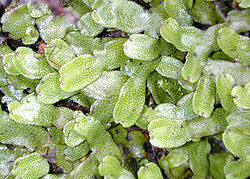
Hornworts
Bryophyte with no leaves that fixes N2
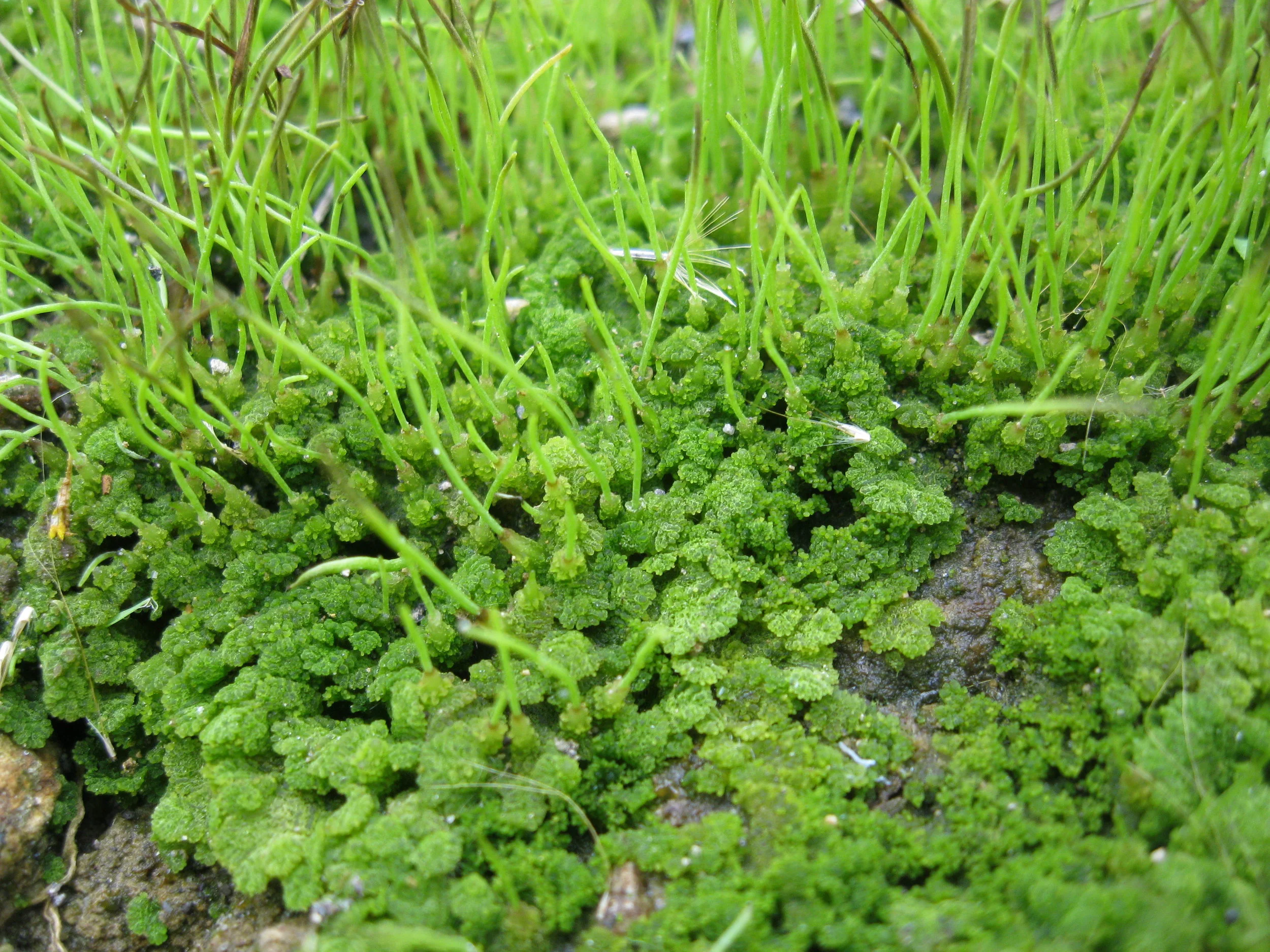
Moss
diverse, first plants transporting sugar/water
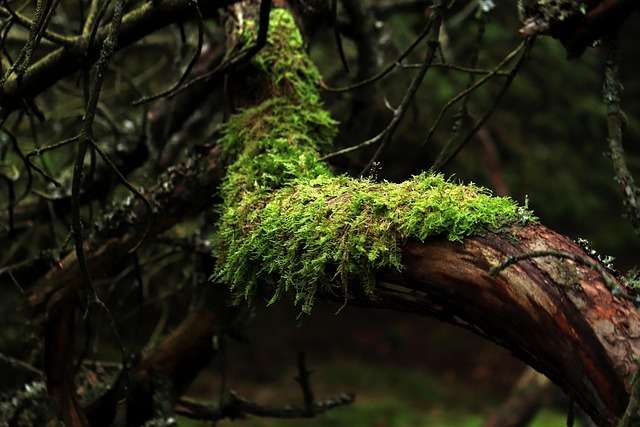
Seed producing vascular plants: Angiosperms vs gymnosperms
Angiosperm = flowering, flat leaves, reproductive system in flowers, seasonal energy storage
ex apple tree, walnut tree, wheat
Gymnosperm = non flowering, needle leaves, reproductive system in cones, evergreen, lower CO2 turnover
ex pine, spruce
Evolution from Algae --> Angiosperm
Algae: photosynthetic ocean organism
(land) bryophytes: non-vascular land plants
(vascular) pteridophytes: seedless vascular plants
(seeds) gymnosperms: non-flowering vascular plants
(flowering) angiosperm: flowering vascular plants
Valivov Centers
Home origins of plants
Fertile Crescent: region with earliest domesticated crops
Top 5 grown crops
*Top 4 - 45% all grown crops
sugar
maize
rice
wheat
potato
Dietary components from plants
starches (potatoes, grasses)
sugar (cane)
vitamins (from leaves/stems)
protein (beans, legumes)
fats (nuts, oils)
Optimal qualities during domestication
tough stem (survives harvest)
large plant parts (optimizing growing resources)
color (antioxidants which lower disease/cancer risk)
Species
Individuals who:
are capable of breeding
producing fertile offspring
have free exchange of genetic material
Speciation
two populations become genetically different/isolated from one another where they become unable to breed
Natural Selection
highest fitness will provide disproportionally more to future generations' gene pool because they are more likely to survive. "Survival of the Fittest"
classification
Kingdom, Phylum, Class, Order, Family, Genus, Species
Crop modification
examples:
modifying maize to have greater # of edible grains
increasing photosynthetic efficiency by altering angle of plant canopies to increase sun intake, CO2 absorbed and energy produced
modifying to have preferred color/taste/aesthetic of crops
Crop modification
examples:
modifying maize to have greater # of edible grains
increasing photosynthetic efficiency by altering angle of plant canopies to increase sun intake, CO2 absorbed and energy produced
modifying to have preferred color/taste/aesthetic of crops
Genetic diversity promotes
crop yield
quality
stress tolerance
Blight
parasitic fungus quickly infecting potatoes/tomatoes. No blight resistance can easily lead to famine
Plant likely to survive if
a lot of seeds w/ high germination likelihood
wide dispersion of seeds
qualities that deter interference by pathogens/predators
Successful crop/food cultivation
characteristics produced that are desired by the breeder
yields high volume of food
reliable crop spread and reproduction
disease/pest resistance
Ethnobotany
relationship between chemical properties/components of plants and indigenous use
Compound groups within ethnobotany
Glycosides - cardiac medicine. Strengthens heart/heartbeat
Alkaloids - Used for pain relief. N2 is a main component
Terpenes - essential oils and chemotherapy. Emitted by trees thus producing own microclimate
Bioremediation vs Phytoremediation
Bioremediation: microbes breaks downs and degrades organic pollutants
Phytoremediation: plants absorb/accumulate pollutants to remove them
Nutrients deemed essential if
an element-specific deficiency makes organism unable to survive/reproduce
element is directly involved in plant nutrition
Primary macronutrients
Nitrogen - comprises proteins/nucleic acids
Phosphorus - comprises nucleic acids, ATP, phospholipids
Potassium - involved in stomata opening, cell water balance, enzyme activation
SO2 effect in plants
Since humans have begun to clean SO2 out of atmosphere, plants who began to rely on it are now becoming sulfur deficient
Plant Response Curve (PRC)
Plants have an optimal range when responding to factors like temperature and nutrients. A surpassing the plant's limit of tolerance results in plant death. Different plants will have varying optimal ranges/responses
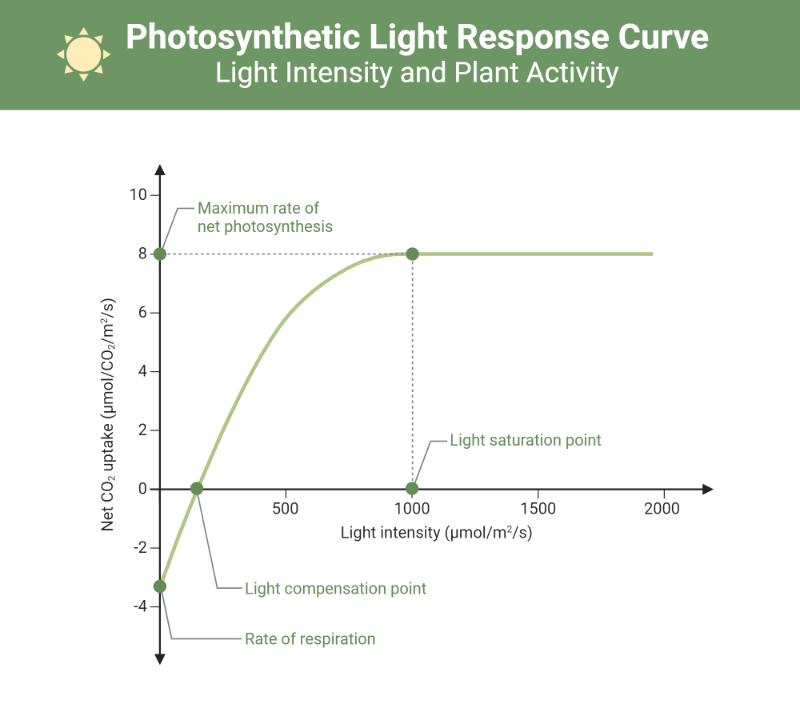
Effects of competition on PRC
species have to adapt to resource quantities that may be taken by other species. This results in a change in growth rate between species
Physiological Optimum vs Ecological Optimum
Physiological Optimum is the alleged optimum (when tested in a lab), whereas the ecological optimum is the optimum observed in nature, considering naturally occurring factors that affect it (ex competition)
High Nitrogen effects
increase in species that thrive in N2 environment, wiping out anything else
lower plant & animal biodiversity
increased eutrophic waters/algal bloom
Limiting Factors Principle
if X element limits growth at a certain quantity, no other element's presence/quantity can create greater yield of that plant. With X element reaching a quantity past the plant's tolerance, it becomes indifferent to any other element
Cation exchange in clay particles
CO2 from roots is released and mixes with H2O to form carbonic acid
clay particles uptake H+ from carbonic acid and exchanges for a K ion that is given back to the root
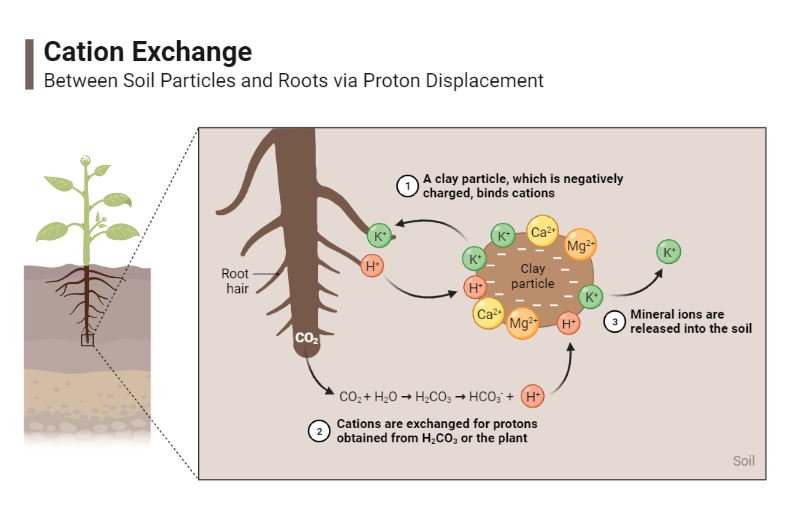
Nitrogen Cycle
lightning fuses N2 + O2 into nitrates, which is rained into soil
N-fixing bacteria transform nitrates into ammonium (NH4)
Nitrifying bacteria oxidize NH4 to NO3
a) NO3 assimilates back into soil/roots
b) Denitrification bacteria reduces NO3 back to N2 into atmosphere
**anthropogenic mineral fertilizers adding excess N2 to this cycle
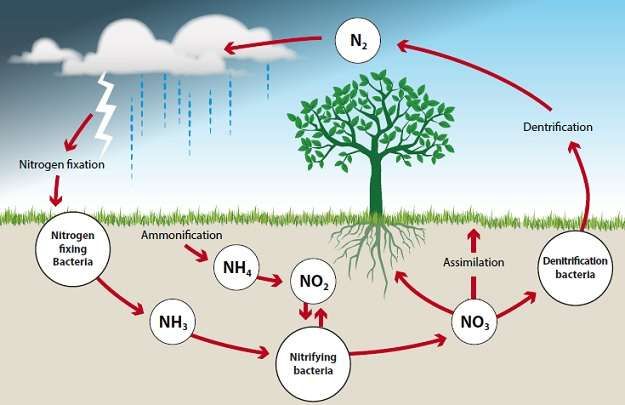
Amino Acid structure
amino group, side chain, carboxyl group
Mutualism of nitrogen fixation
N-fixing bacteria invade/colonize root cells to supply nitrate/ammonium to plants. In return, plants supply organic acids to the bacteria
Nitrogenase
enzyme used by N-fixing bacteria to fix N2. It reduces (adds H) N2 three times to create two molecules of NH3
Metallophytes
Plants capable of growing in soils with high amounts of heavy metals to avoid competition
Nutrients' movement due to
mass water flow leads to new root uptake
root moves to new area
diffusion. High concentration to low concentration
Phosphorus Cycle
rock erosion, mine extraction, and fertilizer all deposit phosphorus into bodies of water
dissolved phosphates are uptaken by plants in soils and organisms in surrounding waters
phosphates from organism decomposition goes to sediments, which becomes new rock through geologic uplift
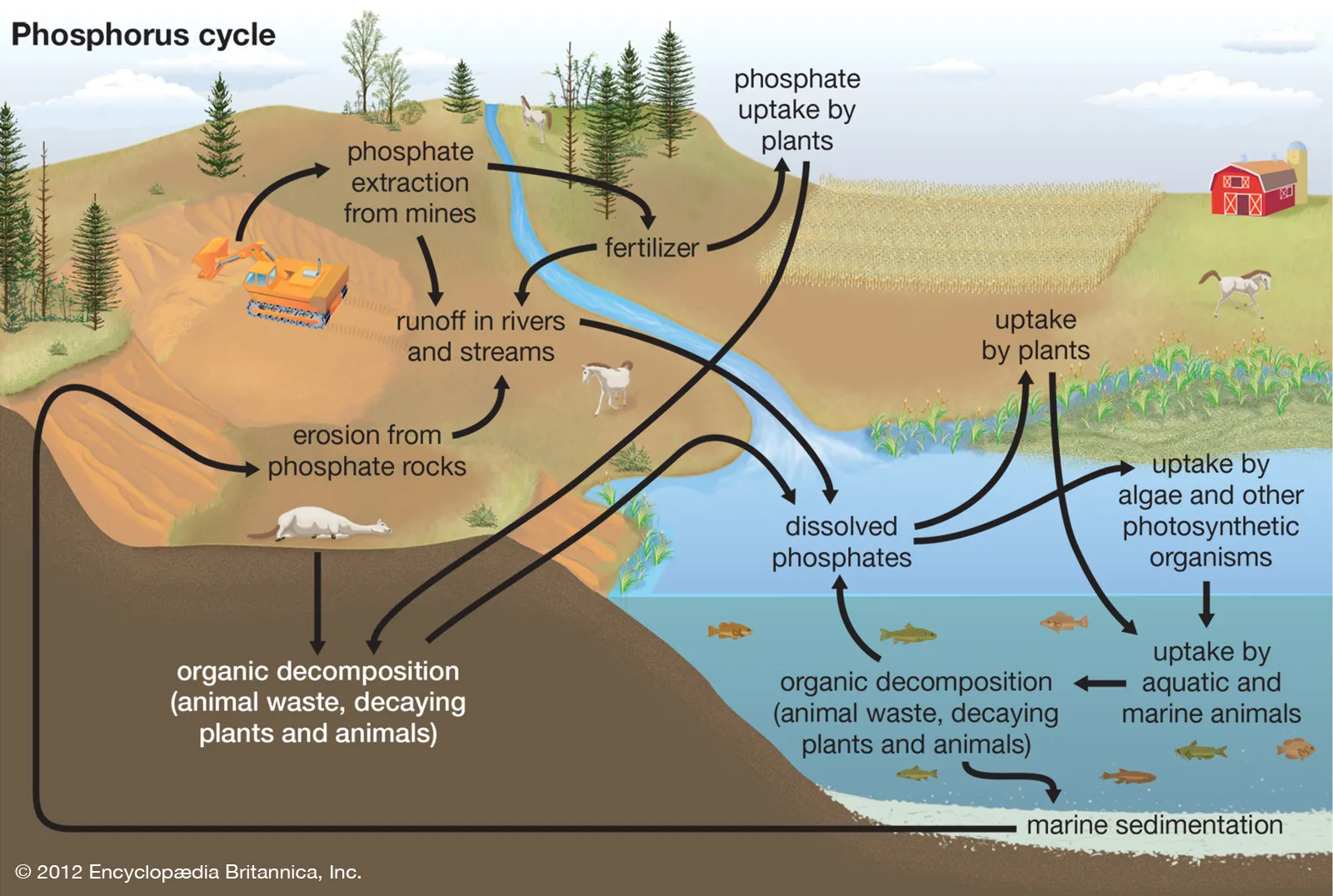
Mycorrhiza fungi
produce hyphae/arbuscules, of a high surface area, which help with phosphorus transport in plants. (Greater surface area means a greater ability to gather material). The fungi concentrate metal ions in plant root tissue
Potassium (K)
maintains water balance/osmosis in a cell and performs special functions to open/close stomata. Therefore, less potassium means a greater chance of plant dehydration/drought.
Cell rehydration with potassium
Potassium is pumped into a dehydrated cell, so the cell is no longer flaccid and water can follow gradient to hydrate cell
Chlorosis
lack of chlorophyll in a plant (due to N2 deficiency). Leaves will begin to turn yellow
Types & effects of nitrogen deposition
wet deposition - ammonium (NH4) and nitrate (NO3) deposited via rain
dry deposition - physical contact with air/land
*increased N2 deposition lead to increased harm (ex more insect damage on plants or less needle retention on trees)
Essential macronutrients in plants
N P K S Ca Mg
Serpentine soils
formed by weathered mineral containing high levels of toxic metals
Importance of Sulfur in plants
in thiamine - Vitamin B10
glutathione - chlorophyl synthesis
biotin - strengthens hair (in humans)
Impacts of low Sulfur
reduces formation of nodules in legumes. Thus less N fixation
in wheat - leads to less gluten/poorer bread quality
Amino acid sulfoxides
from sulfenic acid
once-separated enzymes combine with sulfenic acid, producing eye-irritant sulfur oxide
sulfuric acid burns the eyes. Eyes produce tears as response to wash acid away
Magnesium in plants
component of chlorophyl - critical to photosynthesis
phosphorus carrier
part of protein synthesis
Mg deficiency symptoms first appear in older/lower leaves
Calcium in plants
Calcium Pectate - important in cell wall cementing for stability/structure
sturdy bones (in mammals)
component of amylase - catalyzes conversion of starch into sugar
Zinc in plants
phytotoxin but needed in small amounts
component of Carbonic Anhydrase - transforms CO2 to H2O and HCO3 (bicarbonate)
(in mammals) supports immune function
majority of plants’ enzyme activity levels decrease as Zn levels increase
Iron in plants
oxygen in plants
(mammals) need Fe to transport O2 in blood (hemoglobin)
needed for N fixation
component of Ferrodoxin: electron transfer in photosynthesis
Manganese
catalyst in phenolic compound synthesis
regulate proteins in plants
needed in photophorylation
Sodium
not essential for plants
analogous to K (open/closing of stomata for water balance)
Chloride in plants
balances positive charges of K Ca Mg
Iodine
no major function in plants, but plants serve as carrier for animals
Iodine helps with thyroid hormone production
Silicon in plants
improves cell wall rigidity/structure
forms barrier against parasitic fungi
fights herbivory by making plants unpalatable/undigestible
Cobalt in plants
synthesized by bacteria
component of vitamin B12
deficiency in humans - nervous system issues
Molybdenum
component of nitrogenase
helps with N fixation by root nodules —> important for legumes’ ability to fix N
human deficiency —> developmental delay
Selenium in plants
required for aiding disease resistance/antibody production
low Se in soil/forage = land animals to develop White Muscle Disease (nutritional muscular dystrophy)
plants are carriers for mammals —> Se is component of selenocysteine (human antioxidant)
Boron in plants
affects plant reproduction
deficiency - empty pollen grains, poor pollen vitality, stunted root growth/function
Nickel in plants
vital component of urease
catalyzes hydrolysis of urea into NH3 + CO2 (later absorbed into roots)
Ni deficiency - build up of urea, necrosis (plant cell death) in leaf tips
less Ni = less germination of seeds
Arsenic in plants
metabolism of methionine (Amino Acid in DNA function)
may be part of gene silencing
Aluminum in plants
limits plant growth
complicates phosphate —> phosphate deficiency
harms root systems
meristems
dividing cell regions/points for plant growth
Optimal time to graze
plant quality and yield are at the same capacity, which produces maximum biomass for herbivores
Elongated tillers
taller stems from reproductive development
more likely to be grazed
Unelongated tillers
shorter, compact tillers
Importance of grazing
prevents grasses from growing high, drying up, oxidizing
promotes biodiversity within soils
Ruminants
ruminants have a specialized digestive system (rumen) to digest grasses/cellulose
ex cows eat cud and regurgitate it into rumen
ruminants revitalize grasslands
Oligophagous
certain animals’ food choice which is a few, related foods
monophagous
certain animals’ food choice which is one specific food only
Physical defense
plant size can limit predators’ access to eat them
abrasive plant tissues (though some predators adapt)
silica making plant unpalatable
hooks to trap insects
hair/glands are physical/chemical deterrents
ex spines on nettle containing formic acid that injects anything that eats it
Chemical defense
plant matter comprised of high cellulose, low nitrogen
Glucosinolates - volatile oils released
cyanide - released by plants, esp if leaf is crushed by herbivore